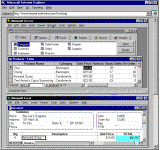

X11R6.3 (Broadway) Overview

|

X11R6.3 (Broadway) Overview |
 An application executing within a web browser using The Open Group's X11R6.3 Technology |
Broadway, was the code name for a ground-breaking initiative evolving the X Window System for creating and accessing interactive applications on the World Wide Web. The resulting technology is the latest release of X, X11R6.3. Any application linked to the Web using X11R6.3 can be located, accessed and executed with the same tools used for accessing static HTML documents today - Web browsers.
You can now have something you've always dreamed of: access to any application, from anywhere on the planet. X11R6.3 just may be the most powerful innovation ever introduced to the World Wide Web. X11R6.3 provides seamless access to remotely hosted programs over the Internet and World Wide Web.
The real purpose of the Web is information sharing. HTML was designed
to
allow static documents to be easily published and accessed using the Web.
HTML has been clearly successful as demonstrated by the growth of the Web
over the past several years. But HTML does have its limitations. Technologies
like Java(TM), Shockwave(TM) and others are poised to fill in the gap between
the capabilities of HTML and the demands of the users. Like
X11R6.3,
each is a tool best suited to solve specific problems.
The design center of the initial implementation of
X11R6.3
requires absolutely no changes to application programs. We have gone
out of our way not to create new APIs that developers must code to allow
their applications to be "Web accessible".
A central concept in X11R6.3 is the ability to
remotely
invoke applications. There are several tools for effecting this in existence
today - UNIX "r" protocols e.g., rsh, rexec, and others. Even
CORBA object requests can be looked at as fitting general description. There
are several problems common to the existing - approaches e.g., they're not
available on all computing platforms and they are too hard for the average
user (non-developer) to get their arms around. The remote execution component
of X11R6.3 is designed to overcome these problems. First,
it has been seamlessly integrated into the structure of the web; this addresses
the ease of use issue.
Second, X11R6.3 integration with HTTP protocols
makes
access to applications platform independent. This is what we call "Universal
Access", referring to the capability to find, launch and interact with
any application from anywhere - a breakthrough in connectivity.
Going hand in hand with Remote Execution is the embedding capability
implemented
as a Web Browser plug-in. Recognizing that Web browsers are quickly becoming
a choice of desktop for some users and information providers,
X11R6.3
embeds the output of applications directly within a page of a Web browser,
adding significant power to the "Web Browser Desktop".
From point of view of the a Web page creator,
X11R6.3
gives exacting control over how a Web page looks, in a way not available
using HTML alone. It provides layout control with internationalization and
allows for a full graphics capability, not just static pre-created images.
The X protocol was originally designed for a high-bandwidth connection
-
a local area network environment running Ethernet at 10Mb/sec. The Internet
is not that bandwidth rich...yet. The target for LBX is WAN and serial
line use including direct dial up from home to office and through an Internet
server provider (ISP).
Access to applications is a major shortcoming of the Web. A lot of information
in our world today is stored in the form of applications. Applications that
either are the direct repositories for information, say training or simulations
apps, or applications that are the gateways to information, like database
query and reporting tools. None of this vast repository of information is
easily available to today's Web users. X11R6.3 addresses
this limitation by allowing existing shrink-wrapped or custom applications
to be seamlessly accessed from within an X11R6.3 enabled
Web browser. A major breakthrough in computing and connectivity!
<>
Architectural Overview
There are five X11R6.3 key components:
1) Remote Execution,
2) Web Browser Plug-in,
3) Security,
4) LBX (Low Bandwidth X), high performance Internet distributed graphics protocol.
Remote Execution
Universal Access(TM)
Web Browser Plug-in
Security
X11R6.3 security works with, and in addition to, existing
Web security; it was designed for worldwide export, and requires no changes
to applications. The X11R6.3 security model is simple,
dividing applications into two classes: Trusted and Untrusted. Trusted
applications
are applications inside your firewall gateway. Untrusted applications are
outside the firewall. X11R6.3 security prevents untrusted
applications from stealing, destroying or modifying any trusted application's
data. The security system consists of three pieces. First, a small piece
of code that runs in the corporate firewall. Second, security extensions
in the X11R6.3 server. And third, a security manager that
works with the user to authorize exchanges between trusted and untrusted
applications.
LBX(TM)
The LBX implementation includes many state of the art optimizations including
caching and short-circuiting and compression. And, like the rest of
X11R6.3,
it works without any changes to existing applications.
Performance testing for LBX has put it in the "best of breed"
tier for similar products with a key difference - it's an Industry Open
Standard.
|
|
|
|
|
|
Permission is granted to reproduce any portion of the text or graphic images of this document provided that you prominently display both the copyright notice listed above and the following acknowledgment: Portions of this document have been reproduced with the permission of the copyright owner, The Open Group, Cambridge, MA.